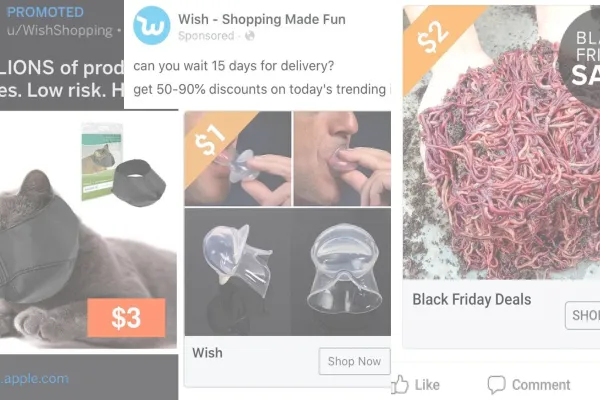
 Details
Details
Social media advertising has grown exponentially in recent years, making it easier than ever for businesses of all sizes to reach their target audience. However, a new trend has emerged in the world of social media advertising: the ‘spray-and-pray’ approach.
In the past, social media advertising was a niche art practised by specialist agencies with a deep understanding of the platforms and their audiences.
These agencies would create highly targeted ads, designed to reach specific groups of people with tailored messages. While these ads were often more expensive to produce and place, they had a higher chance of converting into sales due to their precise targeting. Native advertising is a prime example of this carefully targeted approach.
What Are ‘Spray and Pray’ Ads?
However, in recent years, the rise of self-serve advertising platforms and tools has made it easier for anyone to create and place ads on social media. As a result, many businesses are now opting for a “spray-and-pray” approach, creating generic ads that are aimed at a broader audience in the hopes of catching the attention of gullible or bored shoppers.
The strategy has its plusses and minuses, Native Advertising Institute founder Jesper Laursen said.
“This approach can be cheaper in terms of production costs and the ads can reach a larger audience, but they may not be as effective in driving sales,” Laursen said. “Because these generic ads aren’t likely to resonate with specific audiences, they will probably result in lower engagement rates and conversions.”
Moreover, this approach can be detrimental to a company's reputation. Overexposure to poorly targeted ads can lead to user frustration and annoyance, leading to negative perceptions of the advertisers and the platform.
READ MORE: Explore the different types of native ads
Hitting the wrong mark
For example, recent ad placements on Twitter have left users irked about the sudden influx of sensationalist, low-quality ads for completely irrelevant products that they have absolutely no interest in.
From tie-dyed Nehru vests to day-glo dashboard-mounted religious icons, these ads are definitely hitting the mark - if indeed the mark is to waste people's time. Twitter’s new owner, Elon Musk, has acknowledged the problem and has vowed to take action on the “irrelevant & annoying ads” (of course, he also promised to step down as CEO after Twitter users voted him out, but that’s another story).
One reason for the prevalence of unwanted digital ads may be the result of poor targeting. Advertisers who rely on basic demographics or vague interests may miss the mark entirely, inundating users with irrelevant or unappealing ads. In addition, the rise of programmatic advertising, which automates the process of ad placement, has led to a surge in generic ads that fail to engage viewers.
Amazon ads on Instagram promote bizarre contraptions from obscure merchants, echoing the shopping site Wish, which was notorious for bizarre ads blitzing shoppers with viral online ads for plastic tongue clamps, leather face diapers for cats and a handful of worms.
Going native
The proliferation of spray-and-pay ads could provide a golden opportunity for effective native advertisers.
Native ads are designed to blend in with the surrounding content on the platform, making them more relevant to the user's interests. This increases the chances of engagement, as opposed to spray-and-pray content, which typically broadcasts generic messages to a wide audience in the hopes of generating a response from a small sliver.
Since native ads are tailored to fit the platform's look and feel, they are less intrusive and disruptive to the user experience. The more aggressive techniques favoured by ‘spray and prayers’ like pop-ups, auto-playing videos, or banner ads can annoy users and lead to ad fatigue.
“Native advertising often leverages data and insights to target specific audiences based on their interests, demographics, or online behaviour,” Laursen said. “This makes the content more appealing and relevant to the targeted audience, leading to higher engagement rates.”
And, since native ads appear similar to the editorial content, users may perceive them as more credible and trustworthy than traditional display ads. This increases the chances of engagement and conversions.
READ MORE: Use these tips to create your native advertising strategy
Spend wisely
Experts point to shrinking ad budgets as a driver of spray-and-pray advertising. Tech industry leaders such as Facebook and Amazon are feeling the pinch as some of their brand and retail clients are reining in their digital marketing budgets.
According to recent quarterly reports, major tech companies have witnessed a notable drop in ad spending. Facebook parent Meta saw a drop of more than four percent in advertising revenue in the fourth quarter of 2022. Meanwhile, Amazon’s advertising business, while still growing overall, experienced a deceleration in its pace of growth in the most recent quarter when compared to a faster gain during the same period last year.
With deep-pocketed marketers pulling back and digital platforms lowering their ad pricing, the door has been opened for less scrupulous advertisers to flood the market with misleading pitches.
Due to the increased pressure on marketers to demonstrate that they are receiving a very direct return on their ad spending, performance advertising is therefore likely to be embraced by advertisers. This is where the power of native advertising can provide an edge. Native ads generally perform better in terms of click-through rates (CTR), engagement, and conversions than traditional display ads. This is because they are more relevant, less intrusive, and better targeted.
“While shotgunned content might generate more impressions, it usually has lower engagement and conversion rates due to its lack of personalisation and relevance,” Laursen warned.
READ MORE: Accelerate your content with paid distribution – here's how
Aim carefully
The prevalence of unwanted digital ads can have negative consequences for both consumers and advertisers. An overload of irrelevant or unappealing content can lead to ad fatigue, causing consumers to tune out all advertising entirely. Meanwhile, advertisers risk wasting their budget on ads that fail to drive conversions or improve brand awareness.
To combat this issue, advertisers can employ the effective targeting strategies offered by native content that leverage data and insights to reach specific audiences with tailored messages. By creating ads that resonate with viewers, advertisers can maximise the impact of their campaigns while minimising the risk of ad fatigue and wasted budget.




